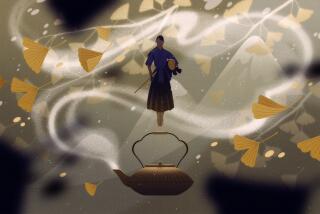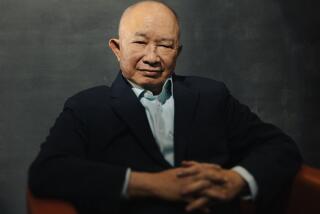Bend it like Tony Jaa
- Share via
Tony JAA’S last name sounds like the roar you’d make while trying to leap up and kick somebody in the head.
And this is something the Thai action star does a lot -- to spectacular, foot-really-touches-face effect -- in the new film “Ong Bak: The Thai Warrior,” which opened Friday on 300 screens nationwide. A few other things Jaa can do: twirl through the air like a propeller, leap over cars, use a crowd’s heads like stepping stones, kick an object being held 10 feet above ground. And if you’re a particularly nasty villain in his movie, he can hurl himself along with a fist, elbow and knee into your body with aerodynamic speed.
These are the kinds of gasp inducers that have led martial arts fans to hail Jaa as the muscular heir to the throne of Bruce Lee, Jackie Chan and Jet Li. “Ong Bak” has already been a hit in Asia and Europe and turned Jaa into a symbol of Thai pride. Now, it’s scoring him Hollywood huzzahs from Wu Tang Clan’s the RZA to directors Brett Ratner and Quentin Tarantino.
The mood was palpably giddy when Jaa demonstrated his gifts with a quintet of stuntmen chums after a recent screening of “Ong Bak” at the Arclight Cinemas. Introduced by the RZA, who at one point let his chest be used as a springboard for one of the star’s back flips, Jaa offered many beaming smiles -- more than he does as the movie’s stern-faced hero trying to recover a Buddha’s head stolen from his village. He also offered a gravity-defying display of his signature discipline, called Muay Thai. By the end, the 28-year-old star’s badge of honor had been reinforced: He’s a no-strings-attached guy, the first of his kind since the wireless days of a younger Chan gave way to marionette-style, effects-enhanced airborne battles.
The whistle-filled standing ovation for Jaa that night felt like a deal being cinched between a tireless entertainer and a kung-fu constituency eager to anoint a new, graceful, organic phenomenon.
“His style is real, and it’s a style to be reckoned with,” said the RZA, a self-described “critical kung-fu movie watcher” who caught a bootleg DVD of “Ong Bak” when it was still only an overseas hit and was immediately blown away. “He showed styles of attack that haven’t been shown on film.”
Earlier in the day, Jaa could be found at Le Meridien hotel between performances for the press, his taut frame comfortably slumping in a chair so that he looked more like a relaxed teen than what some say is the second coming of martial artists.
“Bruce Lee was the first to make Hollywood know there was kung fu, and he had his own hard style,” Jaa said through an interpreter. “Jackie Chan had his fluidity and comedy, and Jet Li has agility. These people are my masters, and I’ve combined these three with my Muay Thai style, which makes me Tony Jaa.”
*
At home with elephants
Born Phanom Jeerum, Jaa hails from Surin, in the poorer northeast provinces of Thailand. His parents raised elephants and a boy who’d jump off those elephants’ backs to practice the wild moves he relished from martial arts movies. (Jaa still has two of those ancestral elephants at his Bangkok home.)
But it wasn’t until the dedicated young Jaa apprenticed with legendary actor-director Phanna Rithikrai, whose 1980s film “Born to Fight” is considered a Thai action classic, that he focused his energies on physical prowess, myriad martial arts forms including taekwondo and swordplay, and a moviemaking education.
When Jaa graduated to being a stuntman, his abilities immediately got him noticed on the set. The rude awakening of a stuntman’s lot soon followed.
“I would tell my friends, ‘Hey, I was in this film, you have to see it.’ Then they would go and tell me, ‘I don’t see you.’ I realized I had to have people know that it was me doing those stunts.”
Out of those frustrations, the “Ong Bak” project was crafted. Jaa and his mentor set about choreographing the myriad daredevil displays and full-contact fights that would require split-second timing and aching perseverance.
“We all agreed you should be able to see the actual hit, and if you can’t, then do it over and over until we get it right,” Jaa said. “But if you get it wrong, you’re a goner.”
The most whimsical scene is also probably the most nakedly thrilling: a market street foot chase that’s merely an excuse to showcase how Jaa can, for example, propel himself through narrow enclosures like a wreath-size ring of barbed wire.
“It’s like Jackie Chan, but Thai style,” Jaa said, smiling. “I am most proud of that scene, because it’s not even violent.”
The showdowns are, though, and if it seems that Jaa’s every joint and protrusion has lethal force, that’s because Muay Thai -- a head-shoulders-knees-feet-hands power package -- was developed centuries ago as a deadly alternative for warriors who’d lost their weapons. The success of “Ong Bak” in Thailand has created a surge of interest for the discipline.
“People get to see the art of Thailand through Tony,” “Ong Bak” director Prachya Pinkaew said recently by phone from Bangkok. “Now, boxing schools have increased the number of locations, and even people in other countries have applied to Muay Thai schools in Thailand.”
Success outside Asia came in the form of French film impresario Luc Besson, a martial arts aficionado who saw the film at Cannes in 2003 and contacted the filmmakers. It didn’t hurt that Pinkaew and his crew had clandestinely placed a written message onto a pillar in “Ong Bak” that reads “Hi, Luc Besson, we are waiting!” (It’s in the left-hand corner of a shot featuring a spectacular tuk tuk crash.)
Besson bought the Western rights, trimmed the film, and added a funkier, more propulsive music track. Magnolia Pictures bought the U.S. and Canadian rights from Besson last year, and president Eammon Bowles said he is still pinching himself.
“There is no doubt in my mind he’s going to be the next great action hero,” Bowles said.
The movie has already generated intense interest on the web, where chat room talk can’t praise Jaa enough, and through bootleg DVDs and Internet downloads. Because word of mouth is everything for an unknown quantity, Bowles is happy that a PR machine is already in place and wonders whether expanding to 2,000 screens is an attainable goal.
“There’s a total underground fan base for it, and we’re going to let them do the work, and hopefully [we’ll] get it out in a bigger way in coming weeks,” Bowles said. “It’s Tony’s time.”
Plus, in the “kung fu head” community, fewer joys exist than introducing that hot new find to your pals and watching them trip on it. Especially when, as the RZA points out, one of those friends is been-there-seen-that king Tarantino. “He’s always got something you’ve never seen,” said the RZA. “This time I had something he didn’t see, right? I was like ‘Ha ha ha.’ That’s the best feeling. It’s an ego thing, but he loved it. All my friends love it.”
Jaa says he has more to show us too. The film he’s been shooting in Australia with the same creative team, “Tom Yum Goong” -- in which he’ll play another avenging country boy but now chasing a pilfered pachyderm -- will feature martial arts disciplines wuzu, capoeira, and, Jaa hints cryptically, “the use of elephants in Muay Thai.”
Sure, scratch your head now, but we’ll all be gaping later.
“There’s so much in Muay Thai, I won’t run out,” said Jaa, who has already learned the showbiz rule of leaving audiences wanting more and actually having more to show. “It’s like Jackie Chan movies, where you were always wondering, ‘What’s he going to come up with next?’ ”
More to Read
Only good movies
Get the Indie Focus newsletter, Mark Olsen's weekly guide to the world of cinema.
You may occasionally receive promotional content from the Los Angeles Times.










